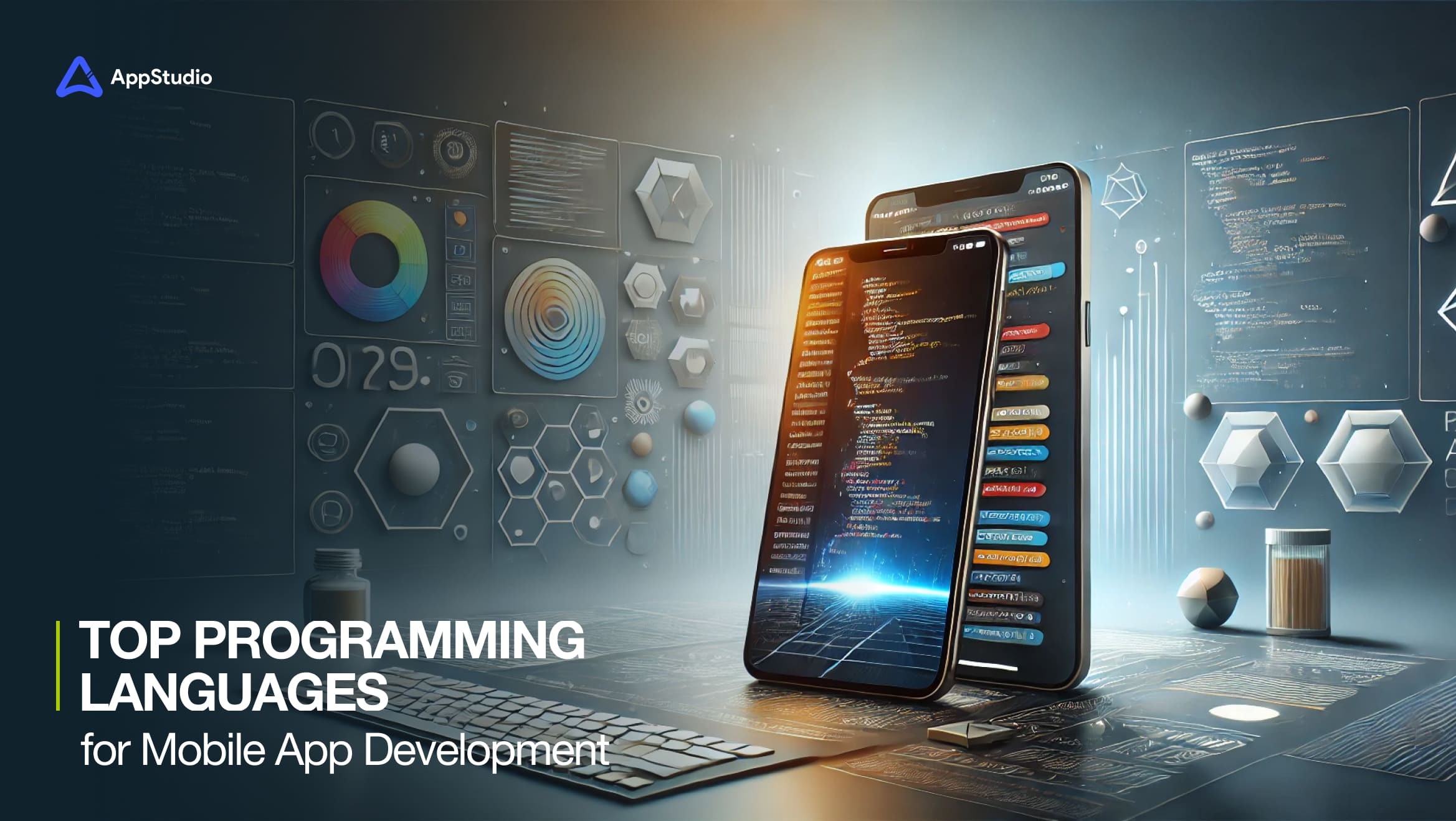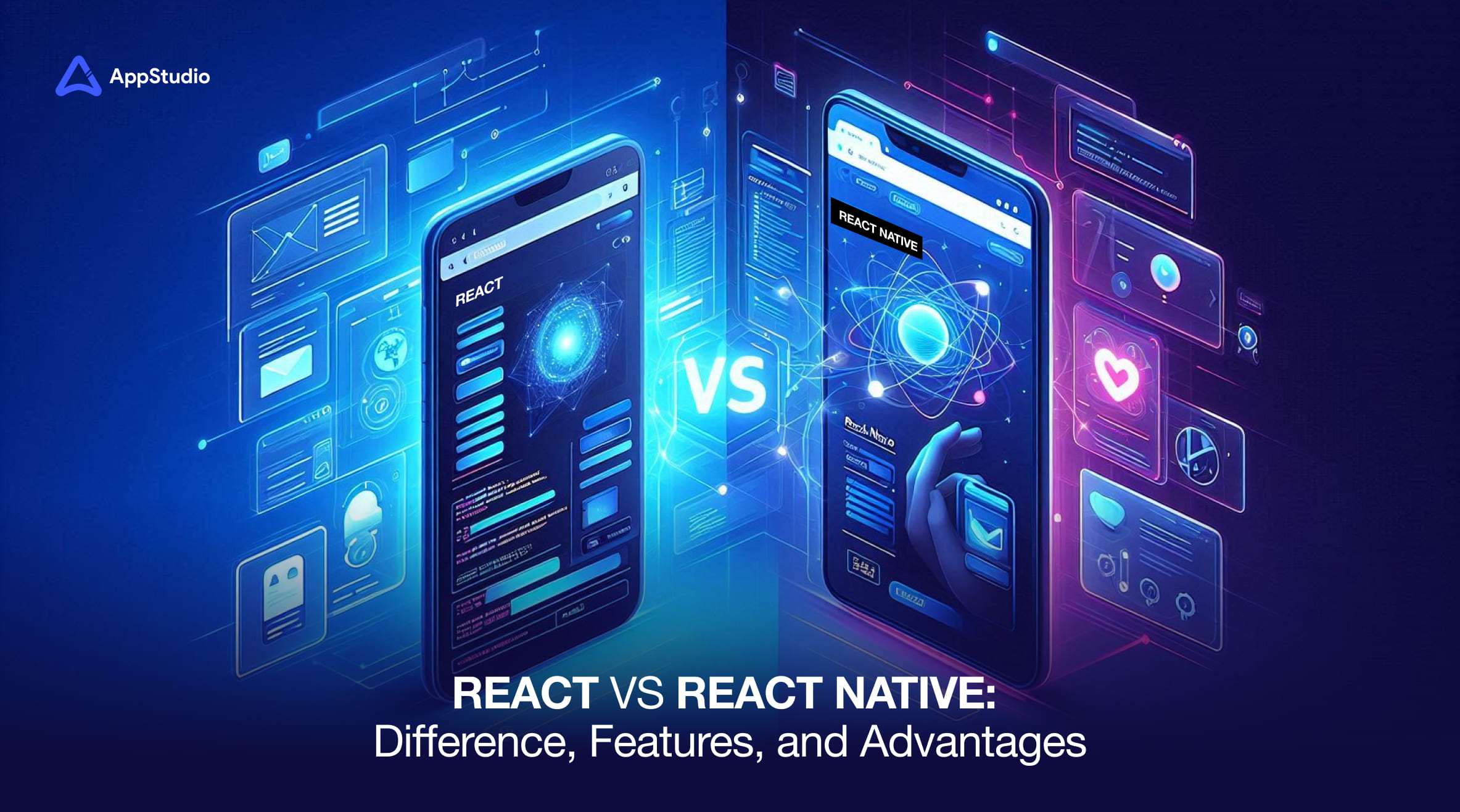The mobile app market is on a meteoric rise and is expected to hit $2.2 trillion by 2030. This isn’t just about numbers—it reflects how apps have become indispensable tools for work, life, and play. As 2025 approaches, businesses are in a race to meet consumer demands, making mobile app development cost a top priority to skim through. Whether you’re a small business stepping into the digital space or an enterprise seeking a competitive edge, knowing what drives the cost to build an app will help you invest wisely.
Each decision impacts your budget, from design complexity to platform choices and ongoing maintenance. Understanding these factors now can mean the difference between building an app that thrives or fades into obscurity. In this article, AppStudio will help you explore what shapes development costs and how to maximize value in this technology-driven ever growing market.
Guide on Mobile App Development Costs in 2025: What’s Included?
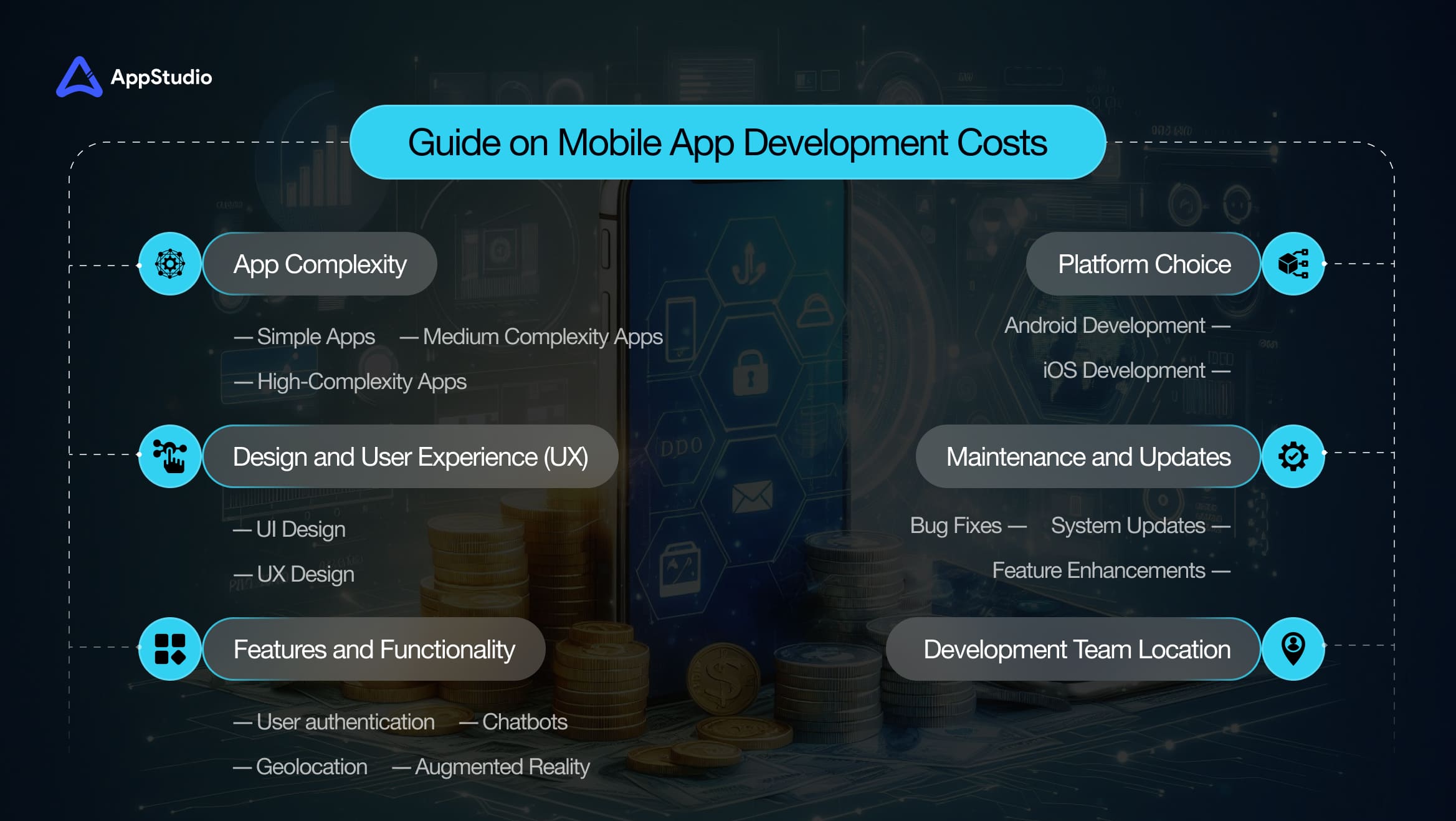
Understanding the cost to develop an app in 2025 requires breaking down the core components influencing the final price tag. Whether you’re a startup working on a budget or an enterprise aiming for a robust, feature-rich app, recognizing where your investment goes is key to making informed decisions. Let’s explore the key factors that shape the average cost to develop an app.
1. App Complexity
The complexity of your cost to build an app is one of the most significant budget drivers. Apps can generally be divided into three broad categories:
- Simple Apps
- Medium Complexity Apps
- High-Complexity Apps
- Simple Apps: These include basic functionality, 3-4 screens, and minimal user interaction. Examples include calculator apps or simple note-taking tools. Creating an app of this nature typically costs between $20,000 to $50,000.
- Medium Complexity Apps: These apps have more features, such as user logins, API integrations, or payment gateways, and their costs range from $50,000 to $80,000. Examples include food delivery or fitness tracking apps.
- High-Complexity Apps: These involve advanced functionalities such as real-time data syncing, complex algorithms, AR/VR features, or integration with third-party services. Due to the resources required for development and testing, such apps often exceed $200,000. Examples include telecommunication OSS/ BSS (Operations/ Business) software applications that require multiple software modules & stack integration to function.
In consideration to these categories, the level of complexity must align with your business goals, as additional features can drive user engagement and add to overhead costs exceeding the average cost to develop an app.
Related reading: What is The Mobile App Development Process?
2. Platform Choice
Your decision to develop for iOS, Android, or both platforms can significantly influence the cost to develop an app.
iOS Development: Known for its strict design and performance guidelines, iOS development often demands greater attention to detail and polish, which can increase costs. However, targeting Apple’s ecosystem provides access to a high-value user base.
Android Development: While Android development can be more cost-effective, it often requires additional testing for compatibility across various devices and screen sizes. This can add time and effort to the overall development process.
3. Features and Functionality
The features you include will determine both the app’s usability and cost. Some of the most common and go-to features include:
- User authentication (logins, multi-factor security)
- Payment gateways for secure in-app transactions
- Social media integrations for seamless sharing and logins
- Push notifications to boost user engagement
- Advanced functionalities like
- chatbots
- geolocation,
- augmented reality, or
- AI-driven personalization.
These factors further increase the cost to create an app.
4. Design and User Experience (UX)
Investing in intuitive design and user-friendly experiences is no longer optional—it’s critical for app success. A visually appealing, responsive app creates a lasting impression on users and ensures higher retention rates. While design investments may seem optional, they significantly enhance your app’s value. Businesses that prioritize design often see better engagement, conversions, and app store ratings, making this a worthwhile area for investment. But how much UI and UX design may actually cost?
- UI Design: Costs can vary based on the complexity of the design elements, animations, or visual assets. A clean, minimalist design may cost less, while an intricate, interactive interface can drive up expenses. Notably, design costs range from $5,000 to $50,000 for a complete project, with designers’ hourly rates averaging $100 to $149.
- UX Design: User experience focuses on flow and functionality, ensuring users can use the app effortlessly. A well-crafted UX reduces abandonment rates and improves user satisfaction. Price wise, similar to UI, UX design can also vary from $5,000 to $50,000, with hourly rates around $112 in the US and $100 in Canada.
5. Maintenance and Updates
Post-launch costs are often underestimated but are critical for an app’s long-term success. Some of the regular maintenance works include:
- Bug Fixes: Addressing unexpected issues or glitches that arise post-deployment.
- System Updates: Ensuring compatibility with new operating system versions (iOS or Android updates).
- Feature Enhancements: Introducing new functionalities based on user feedback and market trends.
6. Development Team Location
The geographical location of your development team plays a significant role in determining the cost to build a mobile app. For instance, app developers in North America and Western Europe demand higher rates compared to those in Eastern Europe or Asia.
While outsourcing to regions with lower labor costs can reduce expenses, it’s vital to consider potential trade-offs in quality, communication, and time zone differences. Thoroughly vetting offshore teams and establishing clear communication channels can help mitigate these challenges. At the same time, the rise of work-from-home job openings allows job seekers to join global teams remotely, while companies can access a broader talent pool.
Related reading: How Long Does it Take to Develop an App?
Top 6 Hidden Costs of Mobile App Development in 2025
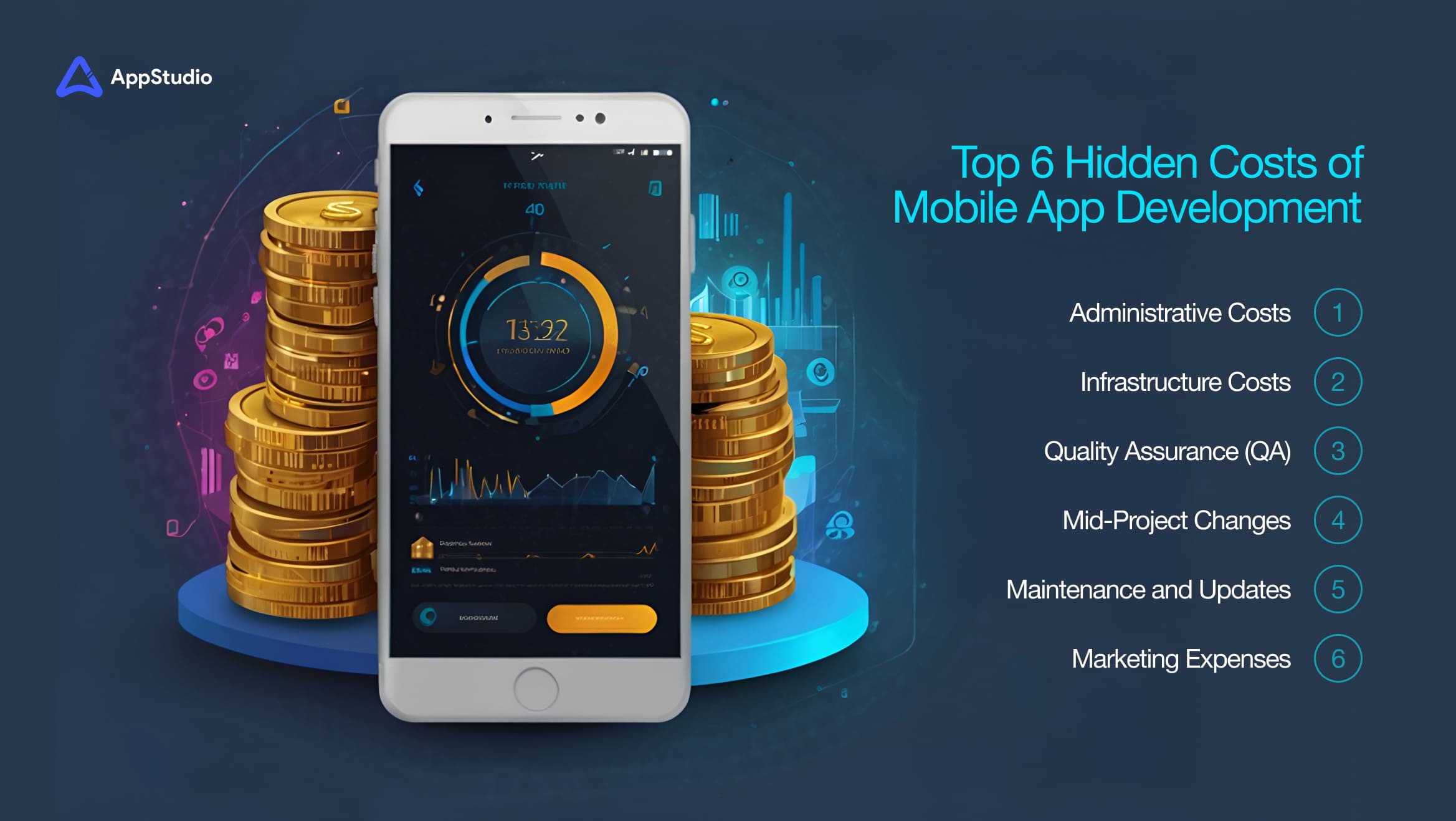
While understanding the cost to create an app involves visible expenses like coding and design, there’s often more beneath the surface. These less apparent, hidden costs can surprise businesses and derail even the most well-planned app development budget if not accounted for in advance. Identifying these expenses from infrastructure to post-launch maintenance ensures businesses are fully prepared to manage their investment and sustain long-term success.
Here are the top 6 hidden costs every business must consider in 2025 that may help you learn more about the mobile app development cost breakdown:
1. Administrative Costs
Administrative expenses cover essential tools and platforms that keep the development process on track. This includes project management software (like Trello, Jira, or Asana), time-tracking tools, and communication platforms like Slack or Zoom. While each of these tools may seem affordable individually, their cumulative cost over months can be significant.
Why It Matters: Administrative systems are vital for organizing workflows, ensuring timely communication, and avoiding costly delays. Ignoring these expenses could hinder collaboration and project efficiency, impacting your app development budget.
2. Infrastructure Costs
Infrastructure is the foundation of every app. It includes hosting services, cloud storage, and robust servers needed for smooth performance and data security. Beyond initial setup, there are recurring mobile app development cost estimate considered for monitoring, scaling, and securing infrastructure—especially if your app integrates third-party APIs or requires advanced databases.
Why It Matters: A scalable and secure infrastructure ensures reliability and performance. Overlooking these expenses could lead to disruptions, additional maintenance costs, or, worse, user dissatisfaction.
3. Quality Assurance (QA)
Quality Assurance is often underestimated but is critical for delivering a seamless user experience. QA involves rigorous testing on multiple devices and operating systems to identify bugs, usability issues, and performance bottlenecks. This stage may require specialized QA engineers and additional tools, increasing the cost of development of an app.
Why It Matters: Cutting corners on QA can launch a glitchy app, damaging user trust and leading to costly fixes down the line. A robust QA process helps ensure a polished, reliable app.
4. Mid-Project Changes
Unexpected mid-project changes often arise as user needs or business priorities evolve. Whether it’s adding new features, redesigning elements, or refining functionality, these changes require additional time, resources, and often unplanned adjustments to the project scope.
Why It Matters: Adapting to changes is essential for creating an app that resonates with users. However, without buffer funds in your app development budget, these shifts can lead to budget overruns or delayed timelines.
5. Maintenance and Updates
Many businesses underestimate the costs of post-launch maintenance. Regular updates to address bugs, improve features, and ensure compatibility with evolving operating systems are non-negotiable for app longevity.
Why It Matters: Neglecting maintenance can cause apps to crash, lose relevance, or fail to meet user expectations. Allocating ongoing funds for updates ensures long-term usability and competitiveness.
6. Marketing Expenses
Developing an app is only half the battle; getting users to download it requires a solid marketing strategy. This includes:
- App Store Optimization (ASO)
- Social Media Campaigns
- Search Engine Marketing (SEM), and
- Paid Advertisements
Many businesses who face under budget marketing efforts, eventually limit their app’s reach and visibility.
Why It Matters: Without strategic promotion, even the most well-designed app risks going unnoticed. A thoughtful marketing approach ensures your investment delivers measurable returns.
Related reading: 14 Easy Steps to Create an App
6 Tips to Minimize App Development Costs in 2025
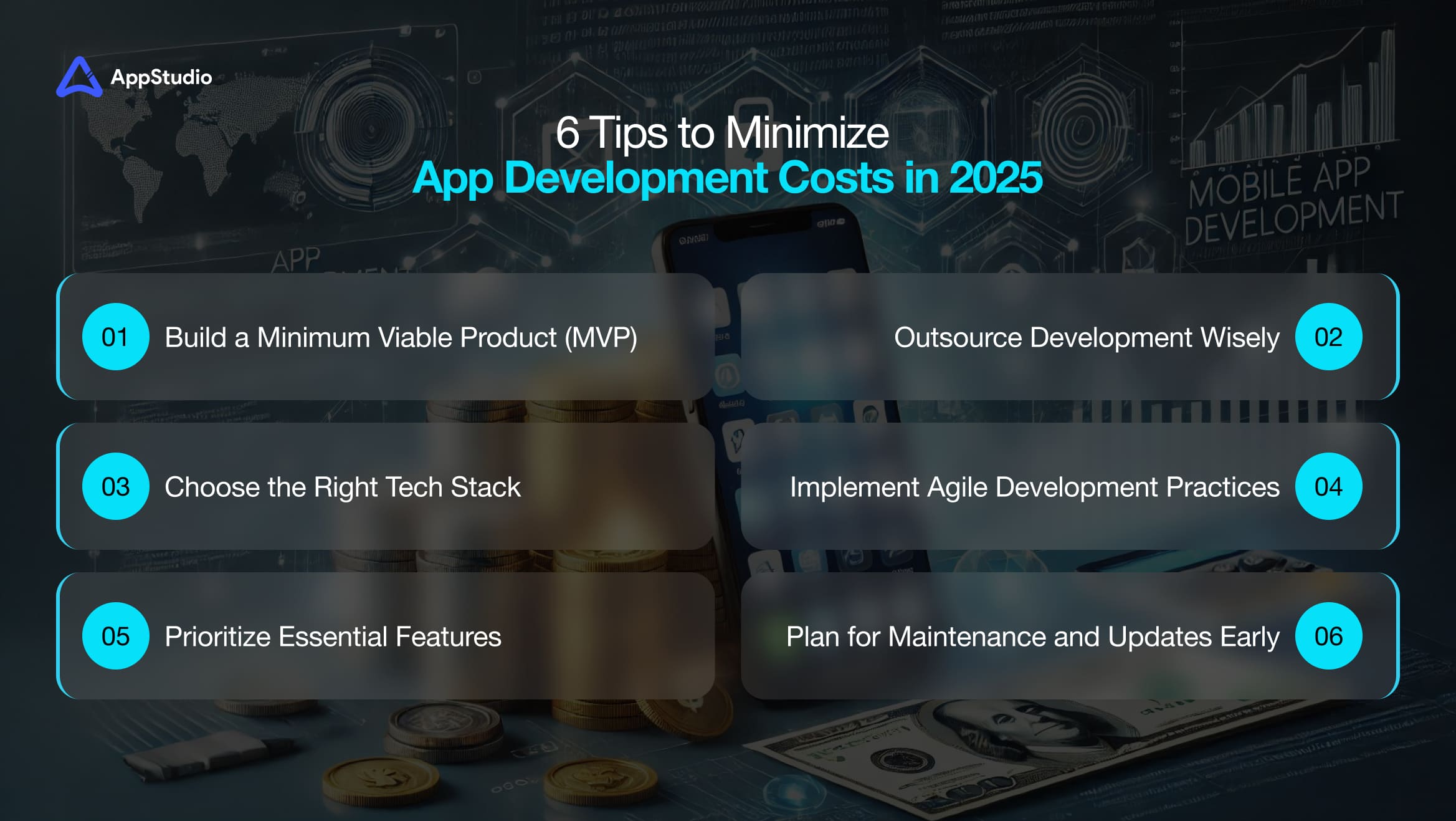
After uncovering the hidden costs that can sneak into your app development budget, it’s clear that controlling expenses without compromising on quality requires a strategic approach. As businesses navigate the evolving digital space, understanding how to manage the mobile application development cost becomes critical for long-term success.
From focusing on core functionalities to choosing efficient development frameworks, the right decisions can make a significant difference in managing your mobile application development cost. So here’s a heads up on mobile app development cost breakdown that you must know about:
1. Build a Minimum Viable Product (MVP)
An MVP focuses on launching a simplified app version with only its essential features. This approach minimizes upfront costs, allowing businesses to test their ideas with real users. Feedback gathered during the MVP development phase helps refine the app incrementally, ensuring a more potent final product without unnecessary spending.
Why It Matters: Launching an MVP accelerates time to market, reduces risk, and ensures that future investments are aligned with user needs, keeping your budget lean and focused.
2. Choose the Right Tech Stack
The technology stack you choose directly impacts the mobile application development cost. Opting for cross-platform frameworks like Flutter or React Native allows developers to create apps for both iOS and Android simultaneously, reducing both development time and costs. Leveraging open-source tools also eliminates licensing fees and accelerates project timelines.
Why It Matters: The right tech stack ensures high performance, scalability, and cost-efficiency, making your investment go further while maintaining quality standards.
3. Prioritize Essential Features
When managing your app development budget, it’s crucial to focus on core features that serve the app’s primary purpose and meet user needs. Adding excessive “nice-to-have” functionalities early on can inflate mobile app development cost estimate and delay the development process unnecessarily. Instead, prioritize building essential features that deliver maximum value to your audience. Notably, a recent study predicts that by 2025, over 70% of successful apps will focus solely on core functionalities in their first release, proving that simplicity and purpose-driven features are key to staying cost-efficient while achieving success.
Why It Matters: A feature-focused approach helps deliver a lean, functional app that aligns with user expectations and saves costs by avoiding scope creep.
4. Outsource Development Wisely
Outsourcing can significantly lower the mobile application development cost without compromising quality—if done smartly. Partner with a reliable development team that has a proven portfolio, strong communication practices, and experience delivering similar projects. Regions with cost-efficient labor, like Eastern Europe or South Asia, offer high-quality work at lower costs.
Why It Matters: Outsourcing provides access to skilled professionals at a fraction of the cost, enabling you to stay on budget while delivering top-notch results.
5. Implement Agile Development Practices
Adopting Agile methodologies helps break projects into smaller, manageable sprints. This iterative approach allows teams to adapt quickly to feedback, solve issues early, and prioritize the most valuable deliverables. By catching problems during development, you reduce the need for expensive fixes post-launch.
Why It Matters: Agile development ensures flexibility, reduces resource wastage, and promotes efficient spending, helping businesses stick to their app development budget.
6. Plan for Maintenance and Updates Early
Maintenance costs can add up if not factored into the initial budget. Regular updates, bug fixes, and performance improvements are necessary to keep the app functional and relevant. By budgeting for post-launch expenses early, businesses can prevent unexpected financial strain.
Why It Matters: Planning for maintenance ensures a stable app lifecycle that reduces the involved cost to create a mobile app by emergency fixes, and keeps your app competitive in a fast-evolving market.
The Most Popular Global Apps and Their Development Cost
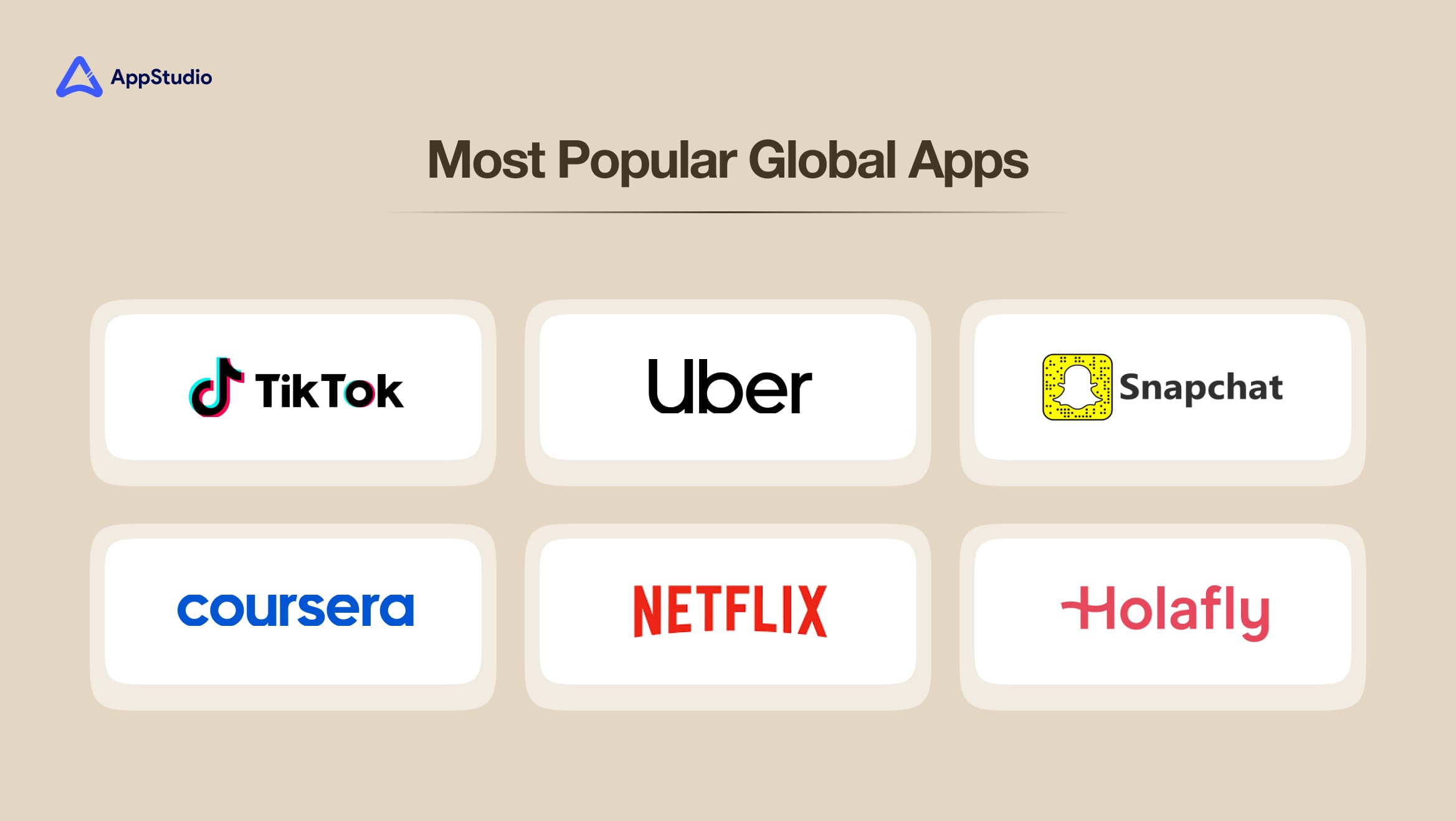
The mobile app industry has given rise to some of the most iconic platforms we use daily, from revolutionizing transportation to redefining entertainment and education. These apps set a benchmark for innovation and investment, showing what it takes to succeed in a competitive market. Building an app with global impact requires understanding the mobile app development cost and the features and infrastructure that drive its success.
In this section, we’ll explore some of the world’s most popular apps, their standout features, and the average cost of mobile application development to create similar platforms. These real-world examples will help grasp the mobile application development cost estimate for turning an idea into a powerful digital product. Have a look:
1. TikTok
Industry type: Social Media
Est. App Development Cost: $70,000 to $250,000
TikTok has emerged as a cultural and digital phenomenon, enabling users to create, edit, and share short videos with music overlays and effects. Building a TikTok-like app requires robust backend infrastructure to handle massive volumes of user-generated content, AI-driven recommendation algorithms, and smooth video streaming features. The average cost of mobile application development for such an app ranges between $70,000 to $250,000, influenced by the sophistication of its algorithm and technical infrastructure.
2. Uber
Industry type: Transportation
Est. App Development Cost: $50,000 to $400,000
Uber revolutionized the transportation industry with its ride-sharing model, connecting drivers and passengers seamlessly. An app like Uber requires real-time GPS tracking, secure payment gateways, and robust user profiles for drivers and riders. The mobile app development cost for building an Uber-like platform ranges from $50,000 to $400,000, depending on the complexity of features, backend infrastructure, and scalability requirements.
3. Snapchat
Industry type: Social Media
Est. App Development Cost: $50,000 to $300,000
With its ephemeral messaging and augmented reality filters, Snapchat changed the social media game with their time-sensitive snap culture . Creating an app similar to Snapchat involves sophisticated features such as real-time messaging, AR-powered filters, and intuitive user interfaces. The mobile application development cost estimate for building such an app typically falls between $50,000 to $300,000, with costs varying based on the level of interactivity and design complexity.
Related reading: 20 Top Mobile App Development Tools
4. Coursera
Industry type: Edtech
Est. App Development Cost: $4,000 to $150,000
Coursera stands out as a leading e-learning platform, offering high-quality educational content from top global institutions. Essential features for building an app like Coursera include video streaming, course management systems, and tools to engage learners effectively. The mobile app development cost for an e-learning platform like this ranges from $40,000 to $150,000, depending on the level of content integration, scalability, and interactivity required.
5. Netflix
Industry type: Entertainment
Est. App Development Cost: $100,000 to $300,000
Netflix dominates the streaming market, providing users with vast libraries of high-definition movies and TV shows. Developing a Netflix-like app involves features like adaptive video streaming, personalized content recommendations, and multi-user account management. The mobile application development cost estimate for such a streaming platform can range from $100,000 to $300,000 or more, depending on content licensing and technical demands.
6. Holafly
Industry type: Telecommunication
Est. App Development Cost: $50,000 to $120,000
Holafly is an innovative eSIM app that simplifies global connectivity for travelers. It enables users to purchase eSIM plans without the hassle of physical SIM cards. To develop an app like Holafly, features such as telecom network integration, secure payment systems, and user-friendly interfaces are critical. The average cost of mobile application development for an eSIM solution typically falls between $50,000 to $120,000, depending on the complexity and scope of its features.
5 Key Formulas to Estimate Mobile App Development Costs
When planning a mobile app, one question often looms: “What will it cost?” While every business recognizes the importance of investing in apps, the price tag can feel like a difficult territory. From design and features to ongoing maintenance, the average cost of mobile app development can quickly add up without a clear structure to guide you.
To make things easier, there are methods to break down and predict the mobile app development price. By applying specific formulas, businesses can uncover a transparent app development cost breakdown, helping them allocate budgets wisely without sacrificing quality. Let’s explore 5 key formulas which will help you do the math of mobile app development costs without charging your head against the wall. Have a look:
1. Total Development Cost Formula
This formula offers a comprehensive way to calculate the total cost by breaking down all the development phases. It includes design, platform-specific development, backend setup, quality assurance, project management, and post-launch support.
Formula:
Total Cost = (Design Hours + Platform Hours + Backend Hours + QA Hours + PM Hours + Support Hours) × Hourly Rate
By summing up the time required for each component and multiplying it by the hourly development rate, businesses can gain an accurate mobile app development price estimate. This method ensures that no stage of development—big or small—is overlooked, giving a detailed view of the final investment.
2. Feature-Based Costing Formula
If your app includes multiple features, this formula is ideal for calculating costs based on individual functionalities. It is especially useful for apps with varying levels of complexity across their features.
Formula:
Total Cost = ∑ (Cost per Feature × Time to Develop Each Feature)
Each feature is broken down into the time and resources required to build it. By summing these components, businesses can identify which functionalities drive up the app development cost breakdown and prioritize core features that deliver the most value.
3. Agile Development Costing Formula
Agile development divides the project into sprints—short, iterative cycles where specific tasks are completed. This formula provides flexibility in cost management and accommodates evolving project requirements.
Formula:
Total Cost = Number of Sprints × Cost per Sprint
This approach allows teams to budget dynamically, as adjustments can be made based on progress and feedback. It’s particularly beneficial for businesses balancing costs while delivering a high-quality product in phases.
4. Time-Based Costing Formula
As one of the most commonly used methods, this formula emphasizes the time required for development.
Formula:
App Development Cost = Total Development Time × Hourly Rate
This method calculates the cumulative hours spent on all stages—design, coding, testing, and deployment—and establishes a clear baseline for the project’s mobile app development price. It’s an effective approach for businesses looking to budget based on developer hours.
5. Complexity Factor Formula
The complexity of an app—whether in design, features, or backend logic—significantly influences development costs. This formula accounts for varying levels of sophistication.
Formula:
Cost Factor = (Base Cost) + (Complexity Multiplier × Base Cost)
Here, the base cost is multiplied by a complexity factor that reflects the app’s scope and advanced requirements. Apps with intricate features like AI integration, real-time processing, or multi-platform compatibility require additional investment, and this formula ensures those needs are accounted for accurately to help you figure out the cost of developing an app.
Related reading: Complete Guide to Application Development Life Cycle
Wrapping Up!
As businesses race to capitalize on a booming app market, the numbers speak for themselves—global app installs are set to hit 230 billion by 2025, growing at a steady 10% CAGR. This explosive growth highlights a simple truth: mobile apps are no longer an option but a necessity for staying relevant and competitive.
However, building a successful app requires more than just an idea; it demands smart planning, precise execution, an understanding of the app development cost breakdown and relevant industry experience that can help you ace your game — the way you want! This is exactly where AppStudio comes into your rescue. Our team of experts transform your vision into high-performing, user-centric apps that deliver real-world results—without straining your mobile app development price expectations alongside offering you custom mobile app development pricing that fits all business sizes and budgets.Book a Free Consultation today, and let’s turn your idea into a game-changing app that thrives in 2025 and beyond!
Frequently Asked Questions
The mobile app development process involves several critical stages: ideation and conceptualization, analysis and planning, UI/UX design, app development, testing and quality assurance, deployment, and ongoing maintenance. Each stage ensures the app is user-centric, functional, and aligned with business goals helping you determine the cost of developing an app.
Custom app development provides solutions tailored to your business needs, enhances user experience, ensures better security, and supports scalability as your business grows. While the initial cost may be higher, it is more cost-effective in the long term than generic solutions.
The development timeline depends on the app’s complexity, features, and design. A simple app may take 3-6 months, while complex apps with advanced functionalities can take 9-12 months or longer.
Choosing between iOS, Android, or both depends on your target audience, market demographics, and budget. Cross-platform development can save time and costs for a wider reach while ensuring a seamless experience across devices.
AppStudio combines technical expertise with a deep understanding of business needs to deliver top-tier mobile applications. We prioritize collaboration, user-focused designs, and cutting-edge technologies to build stand-out apps. Our end-to-end support ensures your app not only launches successfully but also evolves to meet market demands.





